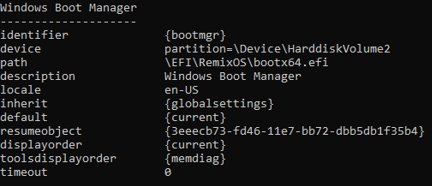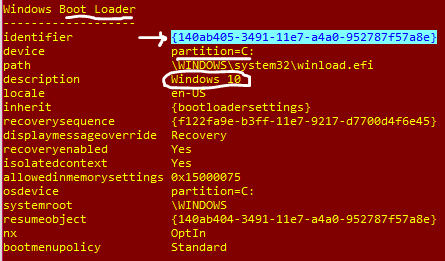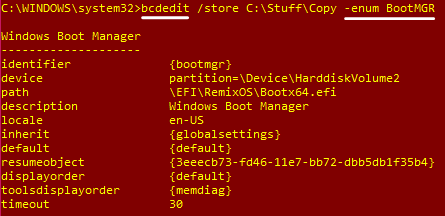How To Delete Apps On Remix Os Player
(1) Make a backup of the current BCD (Boot Configuration Data) Store.
DIR C:\ /ad //List the directories on C:\.
DIR D:\ /ad
DIR E:\ /ad
Stop when you recognize the Windows partition by the folders displayed: Program Files, Program Files (x86), Users, Windows, etc. You are offline. It may still be the letter "C:\" but also may be another. Use the right one in the following...
MD C:\BU //Create a folder named BU on C:\.
BCDEdit /Export "C:\BU\BCD Corrupt" //Backup the corrupt BCD into the file "BCD Corrupt"..
//The BU subfolder is auto-created, if necessary.
If necessary, it can be restored with: BCDEdit /Import "C:\BU\BCD Corrupt"
(2) R egenerate the Boot Manager entry you deleted, which was...

(a) One approach: Do it with BCDEdit.
At any point, "BCDEdit -enum BootMGR" will show the current progress.
Hint: After entering each /Set command, Up-Arrow will recall it for alteration.
BCDEdit /Create {BootMGR} /d "Windows Boot Manager"
BCDEdit /Set {BootMGR} device partition=\Device\HarddiskVolume2
BCDEdit /Set {BootMGR} path \EFI\RemixOS\Bootx64.efi
BCDEdit /Set {BootMGR} locale en-US
BCDEdit /Set {BootMGR} inherit {globalsettings}
BCDEdit /Set {BootMGR} default {140ab405-3491-11e7-a4a0-952787f57a8e} //See note below.
BCDEdit /Set {BootMGR} resumeobject {3eeecb73-fd46-11e7-bb72-dbb5db1f35b4}
BCDEdit /Set {BootMGR} displayorder {default}
BCDEdit /Set {BootMGR} toolsdisplayorder {memdiag}
BCDEdit /Set {BootMGR} timeout 30
Note : To set "default", you must enter your actual GUID value (not mine). I tried to use "{default}" & "{current}", but they didn't work. (But after this, it will work for " displayorder ".) So...
BCDEdit -enum OSLoader //Lists the OSLoaders

Several OSLoader's will show up. Choose the one that is Windows 10. Its description likely will say that (instead of Recovery Environment or Rollback). Also, its device will be a partition (not a RAMDisk), & it will be a Boot Loader (not Setup).
Select the text of the identifier with your mouse (drag it), & use Ctrl+C to copy it. Then, go to the command line & paste it with Ctrl-V. (Or, use the Edit menu provided by clicking the icon in the header of the Command Prompt.)
This is how that went (into my copy of my BCD in "C:\Stuff\Copy", made with "/Export", then I did the delete you did). See how it ends up becoming "{default}" after all...

"{default}" is what shows up as "{current}" when the BCD is online. Yours will be offline until you can reboot. Here is the finished product. It looks just like yours did before the catastrophe, except I gave it a reasonable "timeout"...

(b) Another way: Delete the whole BCD, then recreate it with "BootRec /RebuildBCD".
I'll post instructions separately later.
BootRec only exists at the Command Prompt of the recovery environment (where you are). Normally, "/RebuildBCD" will just add any Windows installation it finds (that isn't already there) into the current BCD. That would only be a Boot Loader entry (not a Boot Manager). But BootRec can be made to regenerate the entire BCD by deleting the current one first. That includes the Boot Manager entry.
To do that, we must put a letter (say, "X:") onto your EFI partition for access. It looks like yours will be Partition 2 (not Volume 2). But I'm unsure where your current BCD is. Normally, it would be at "\EFI\Microsoft\Boot" & the Boot Manager normally is "Bootmgfw.efi". (But I've read that " Bootx64.efi " is actually the same file - but only has a different name.) It's possible your BCD to delete will be in "X:\EFI\RemixOS". We'll have to look & see. If so - will /RebuildBCD be able to handle it?
Here is its help blurb...
X:\windows\system32>bootrec /?
Repairs critical disk structures. The following commands are supported:
/FixMbr -- writes the master boot record of the system partition using the master boot record compatible with Windows. This operation does not overwrite the existing partition table.
/FixBoot -- write a new boot sector onto the system partition using the boot sector compatible with Windows.
/ScanOs -- scan all disks for installations compatible with Windows and display the entries that are currently not in the boot configuration store.
/RebuildBcd -- scan all disks for installations compatible with Windows and allow the user to choose which to add to the boot configuration store.
Edit : Here is maybe a better way to regenerate the full BCD...
https://social.technet.microsoft.com/wiki/contents/articles/36029.windows-10-troubleshooting-error-upgrading-to-build-1607-0x80070057-0x2000a.aspx
Windows 10 Troubleshooting: Error upgrading to build 1607, 0x80070057-0x2000A
Hmm, you still need to find the BCD first. That likely means you need to put a letter on the system partition. But I like the BCDBoot command, as it exists in a booted Windows DOS Prompt...
Edit 2/20/18 : I ran BCDBoot to see what it would do...
https://docs.microsoft.com/en-us/windows-hardware/manufacture/desktop/bcdboot-command-line-options-techref-di
BCDBoot Command-Line Options
It will regenerate the BCD, & probably will be best to delete the current one first. It left some junk in my BCD intact because I didn't delete it first. And I didn't like it writing MBR boot files to my EFI (system) partition, which is GPT style. It didn't hurt anything, really, but I did soon delete them. So, use "/f UEFI" or "/f BIOS" (whichever applies) - not "/f All". Probably, really, it is best to use "BootRec /RebuildBCD", which only does the BCD, not any other boot files.
C:\WINDOWS\system32>BCDBoot /?
Bcdboot - Bcd boot file creation and repair tool.
The bcdboot.exe command-line tool is used to copy critical boot files to the
system partition and to create a new system BCD store.
bcdboot <source> [/l <locale>] [/s <volume-letter> [/f <firmware>]] [/v]
[/m [{OS Loader ID}]] [/addlast] [/p] [/c]
source Specifies the location of the windows system root.
/l Specifies an optional locale parameter to use when
initializing the BCD store. The default is US English.
/s Specifies an optional volume letter parameter to designate
the target system partition where boot environment files are
copied. The default is the system partition identified by
the firmware.
/v Enables verbose mode.
/m If an OS loader GUID is provided, this option merges the
given loader object with the system template to produce a
bootable entry. Otherwise, only global objects are merged.
/d Specifies that the existing default windows boot entry
should be preserved.
/f Used with the /s command, specifies the firmware type of the
target system partition. Options for <firmware> are 'UEFI',
'BIOS', or 'ALL'.
/addlast Specifies that the windows boot manager firmware entry
should be added last. The default behavior is to add it
first.
/p Specifies that the windows boot manager firmware entry
position should be preserved. If entry does not exist,
new entry will be added in the first position.
/c Specifies that any existing objects described by the template
should not be migrated.
Examples: bcdboot c:\windows /l en-us
bcdboot c:\windows /s h:
bcdboot c:\windows /s h: /f UEFI
bcdboot c:\windows /m {d58d10c6-df53-11dc-878f-00064f4f4e08}
bcdboot c:\windows /d /addlast
bcdboot c:\windows /p
C:\WINDOWS\system32>
How To Delete Apps On Remix Os Player
Source: https://answers.microsoft.com/en-us/windows/forum/all/remove-remixos-from-dual-boot/a97accda-9db9-40b2-9c9c-8ce2afe2a1b2
Posted by: mckeelecladmands.blogspot.com

0 Response to "How To Delete Apps On Remix Os Player"
Post a Comment